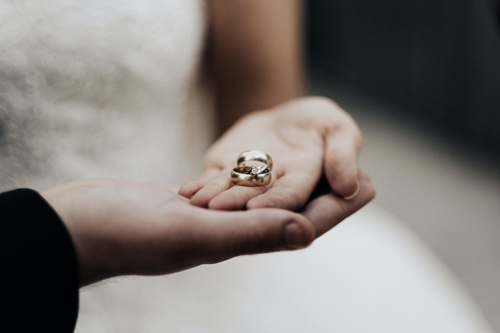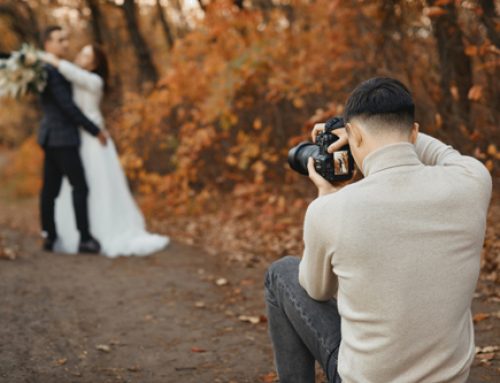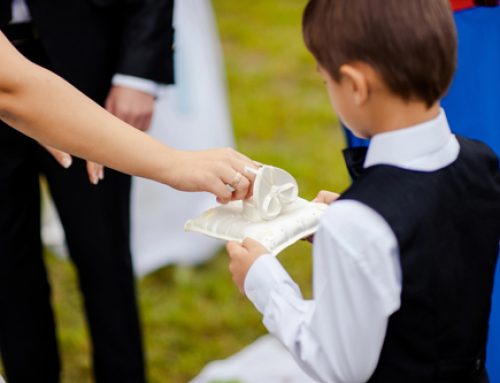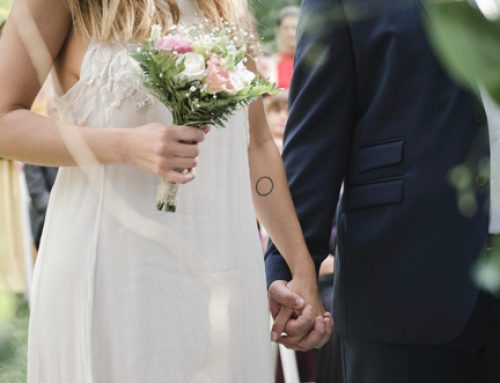How Do the Rings Work in a Wedding? Etiquette and Traditions
There are several long-held traditions for wedding rings and engagement rings — and others that might not be as old as you think. Diamond engagement rings only became popular a century ago following the Great Depression. Diamond retailer De Beers launched a marketing campaign stating that diamond rings were the ultimate symbol of love, and diamond engagement rings have been popular ever since.
Whether you are preparing for a proposal or already planning a wedding, it’s important to understand the various traditions and etiquette that come with the rings. Here’s what you need to know.

Wedding Ring vs. Engagement Ring: What’s the Difference?
The first ring you will encounter when you decide to propose is the engagement ring. This ring is used as a promise of marriage from one person to the next. One partner presents a ring as a gift to the other, and the recipient wears the ring until the wedding day. The engagement ring symbolizes that the wearer will soon be married and cannot accept proposals from any other potential suitors.
On the wedding day, a couple exchanges rings during their vows. The bride receives a band to go with their engagement ring while the groom receives a wedding ring to wear as well. These rings reflect the couple’s commitment to each other and symbolize their marriage for the world to see.
Both engagement rings and wedding rings come in a wide variety of materials, with different metals, stones, designs, and sizes. Couples are starting to embrace creative rings that reflect their personalities.
What Is a Wedding Band?
A wedding ring and a wedding band are similar and the terms are sometimes used interchangeably. The wedding band is presented during the wedding ceremony and is designed to be worn with the engagement ring. Wedding bands are usually smaller and complement the flashier engagement ring design.
Grooms also receive wedding bands during the ceremony. These bands might match the bride’s rings or come in their own unique designs to reflect the personalities of the grooms who wear them.
How To Wear Wedding Rings and Engagement Rings
A bride wears their engagement ring throughout the engagement period and usually continues wearing it after the wedding day. The ring is paired with a wedding band during the ceremony, which is when the groom receives their ring.
Wedding bands are simpler in design compared to engagement rings. They are made from durable materials to suit everyday wear. If you’re busy throughout the day or use your hands a lot, you might not wear your engagement ring because it could get damaged or lost.
Keep durability in mind as you shop for both engagement rings and wedding bands. Rings made out of tungsten are some of the most durable options on the market, and there are plenty of tungsten ring options for women that you can choose from.
Engagement Ring Finger vs. Wedding Ring Finger? What’s the Difference?
There are a few etiquette rules to keep in mind when you propose or receive an engagement ring. When you are engaged, you will wear the ring on the fourth finger of your left hand. This is also where you will wear your ring and wedding band after you are married.
Partners traditionally wear their rings on the fourth finger on the left hand, which stems from an ancient Greek belief that turned into a wedding tradition. Medical practitioners thought the fourth finger has a vein that runs directly to the heart, connecting the love you have for your partner with the rings they give you. The reality is that veins run throughout your body, not just in that finger, but the tradition holds strong today.
Engagement Ring vs. Wedding Ring: Which Goes On First?
Traditionally, the partner who received an engagement ring puts their wedding ring on first and then their engagement ring. This is because the wedding band is supposed to be closer to the heart. This style also makes it easier for you to remove your engagement ring to clean it or to prevent the stone from getting caught while you’re working.
However, modern weddings are all about breaking traditions. You might decide that you want to wear your engagement ring first and find a band that matches that style. Some brides even wear their rings on separate fingers so they can appreciate the engagement ring and wedding band separately. The choice is yours.
Who Buys the Wedding Bands?
When it comes to wedding bands, couples traditionally buy them for each other. The bride gives the groom a band during the ceremony and vice versa. Couples who already live together and have joint bank accounts may break this tradition. The couple can buy the bands together at the same time. You and your partner can decide whether you want to surprise each other with your ring choices during your vows or pick the bands out together ahead of time.
How Much Should You Spend on Engagement and Wedding Rings?
Wedding rings can get expensive if you want them to be. They are one of the most inflated wedding expenses because marketing campaigns place so much value on diamonds and dramatic proposals. The average engagement ring costs $5,800 and couples spend around $2,200 for wedding bands. This brings the total cost of the rings up to $8,000.
You don’t need to spend that much on your rings. A third of couples spend around $1,000 to $4,000 on the engagement ring. The first way to save money on wedding rings and bands is to look for alternative metals and jewels. You don’t have to choose a gold ring with diamonds. You can opt for unique metals and beautiful stones that make your ring stand out. Your rings can still look stunning, and no one will know that your selection helped you save money.
How Do You Wear Your Engagement Ring on Your Wedding Day?
Throughout your engagement, it is customary to wear your engagement ring on the fourth finger of your left hand. However, your ring will get in the way when it’s time to add the wedding band. To avoid this, the bride often switches sides and wears their engagement ring on their right hand during the ceremony. The groom will place the wedding band on the left hand and then move the engagement ring on top of it.
Another option is to move your engagement ring to another finger on your left hand, like your middle or pointer finger. The groom can slip the band on and then return the engagement ring to its normal place without having to fuss with multiple hands.
Some wedding ring traditions are practical — like wearing your engagement ring on top so it is easy to remove and clean — while others date back to ancient Greek medical myths and Great Depression marketing campaigns. You can decide which traditions work for you and which rules are meant to be broken. What’s most important is that you love your rings and the person who gave them to you.




Leave A Comment